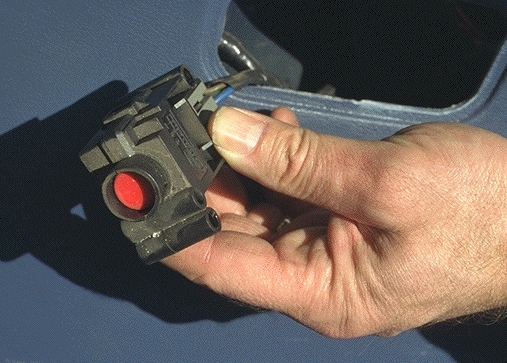Ford Short Circuit Protector Wiring Diagram
Design: Electrical System Protection
A variety of electrical system components are designed to protect against fires. Overcurrent protection devices include fuses, fusible links, and circuit breakers. Wiring design, insulation, termination, routing, and protection are also crucial. Fuel pump shutoff systems are incorporated to limit fuel spillage in the event of a collision. Numerous standards have been published to address some of these issues.
Fuses
Fuses act as a safety valve to prevent current from exceeding the rating of wiring and electrical circuit components. Overloads can occur through either overcurrent or short circuit events. If the current exceeds the rating of the fuse, the metallic fuse "element" overheats, melts, and opens the circuit. It is the intent of the circuit designer to install a fuse that will open long before damage is done to the circuit components. Once a fuse has opened or "blown," it must be replaced before the circuit can be re-energized.
Fusible Links
A fusible link is a short section of wire (about 2 wire sizes smaller than the surrounding wire, per SAE J156 Jun 94) that has a smaller diameter than the rest of the circuit. It acts as a high-current fuse, typically with a capacity of 30 amps or more, that protects circuits from excessive current draw. When current flow in the circuit exceeds that of the fusible link, the wire melts and interrupts the circuit. This type of fusible link is quickly becoming obsolete, as many carmakers have opted for newer technologies such as the cartridge style fuse element or "Maxi" fuses. The location of fusible links varies. The older, wire style of link can be hard to find. It is usually located in a wiring harness near a main harness connection; the fusible link may have a current capacity tag attached. There have been reports that fusible links have initiated fires.
Circuit Breakers
Circuit breakers are circuit protection devices that, like fuses, will open a circuit when current exceeds the rating of the device. Unlike fuses, however, circuit breakers can be reset without replacement. Some are designed to be self-resetting; others require manual reset.
More information about automotive current protection devices can be found on the Littlefuse website [1]:
Wiring
Wire sizing, routing, insulation, termination and protection are important factors in fire causation and investigation. [2, 3]
For more details on conductor size and wire gauging click here.
Fuel Pump Shutoff Devices
Some manufacturers (Ford, in particular) have historically used inertia switches to interrupt power to the electric fuel pump circuit in the event of a collision. These devices are often located in the trunk, and are resettable. Other manufacturers have a different approach. Instead of inertia switches, they use an electrical signal from engine rotation or crash sensors to disable power to the fuel pump. If the engine stops rotating, as would be the case in most serious collisions, power to the fuel pump is interrupted.

Photograph of fuel pump inertial cutoff switch in the trunk of a Ford Escort.
Battery Crash Protection
As described in the battery section of this course, vehicle batteries can be an ignition source when short circuited during a crash. Insulating covers for the positive terminal can reduce the chance of shorting of against other surfaces because of displacement of the battery or deformation of metal.
Some vehicles have mechanisms to automatically disconnect the battery in a crash. There are devices that use a pyrotechnic charge to disconnect the battery cable, and others disconnect battery power electronically. Instrumented vehicle tests with crash-induced short circuits have shown that power is frequently cut off or stabilized early in crash events, even in those vehicles without battery disconnect systems [6].
Standards Related to Electrical Systems
Numerous Society of Automotive Engineers (SAE) standards specify, among other things, insulation type, adherence, wall thickness, dielectric testing, fluid compatibility, pinch and abrasion testing, and tensile strength. [7]
Flammability of wiring insulation (and other materials) in horizontal and vertical positions is covered by Underwriter's Laboratories Standard UL 94 which is entitled "Tests for Flammability of plastic Materials for Parts in Devices and Appliances." [8]
To view references for this section before continuing, click here
Source: https://depts.washington.edu/vehfire/ignition/electrical/elecdesgn.html
Posted by: deko44.blogspot.com